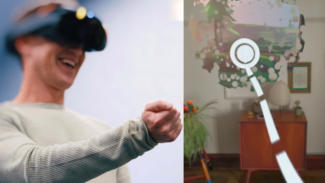Project Cambria has a depth sensor and cameras with 3 times the resolution of Quest 2’s.
Cambria is the public codename for Meta’s upcoming high end standalone headset, announced at Connect 2021 in October. It will be sold alongside Quest 2 with a price tag “significantly” higher than $800, aimed at remote workers and mixed reality enthusiasts. The headset looks to have a more balanced design than Quest 2 with a slimmer visor achieved through the use of pancake lenses instead of fresnel lenses. It also has built-in face and eye tracking to drive avatars in social experiences like Workrooms.
But Cambria’s headline new feature is high resolution color passthrough for mixed reality – Quest 2’s passthrough is grainy black & white. And today in a conversation with Jesse Schell (of Schell Games), Meta CEO Mark Zuckerberg revealed some of the hardware behind this mixed reality functionality.
Zuckerberg said Quest 2’s passthrough is based on “sensors that were not designed to give you anything more than just a very rough outline of what’s going on around you”.
Cambria, on the other hand will have “a bunch of new sensors” including “high resolution color outward facing cameras” as well as a dedicated depth sensor. “Right now on Quest 2 we hack it a little bit by looking at the cameras and trying to intuit what the depth is”. Zuckerberg told Protocol that this sensor is an IR projector for active depth sensing, and also said the regular cameras have three times the resolution of Quest 2’s.
Hardware level depth sensing is also “more optimized towards hands” Zuckerberg told protocol, though Meta has dramatically improved hand tracking even on Quest 2 by leveraging recent advances in computer vision.
Project Cambria still doesn’t have a product name, specific release window, or exact price; but Zuckerberg re-iterated it will launch “later this year”.





